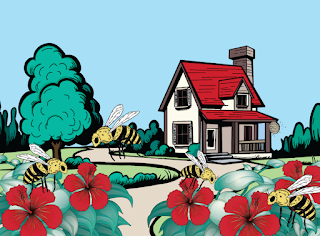Understanding and Coexisting with Bees and Wasps
Bees and wasps play vital roles in our ecosystem, and understanding their behaviors is key to coexisting peacefully with them. Keith S. Delaplane, director of the University of Georgia’s Honey Bee Program, provides valuable insights into the world of these insects, emphasizing their importance and how to avoid conflicts.
Differentiating Bees from Wasps With over 20,000 species of bees, including carpenter bees, honey bees, and bumblebees, it's challenging to distinguish them all. However, bees generally focus on flowering plants, collecting pollen and nectar. Wasps, such as hornets and yellow jackets, are carnivorous and often more aggressive, seeking out meat to feed their young. This behavioral difference makes wasps more of a nuisance, especially during outdoor activities.
Avoiding Stings Most bee species are solitary and non-aggressive, living in individual tunnels rather than colonies. For example, ground-nesting bees create multiple holes in the soil, which are harmless and temporary. On the other hand, yellow jackets and other social wasps defend their nests vigorously. Recognizing and avoiding these nests is crucial to preventing stings.
Carpenter Bees and Honey Bees Carpenter bees are often mistaken for wood-eating pests but actually burrow into wood to create nesting tunnels. They rarely cause significant structural damage. Male carpenter bees, identifiable by yellow patches on their faces, are stingless and can be gently shooed away if they become too aggressive.
Honeybees, essential for pollination, sometimes nest in house walls. If you notice increased bee activity around your home, inspect for potential entry points and seal them if bees are scouting. If a colony has already settled, it's best to call professionals for removal to avoid the unpleasant consequences of melting combs and dead bees inside the walls.
The Ecological Role of Wasps While often seen as pests, wasps play a critical role in controlling garden pests, such as caterpillars and aphids. They help maintain the balance of ecosystems, benefiting home gardeners by reducing the need for chemical pest control.
Conservation and Coexistence To protect these important insects, avoid using pesticides, plant diverse native species, and support local beekeepers. Governments and organizations like the FAO promote sustainable agricultural practices and support beekeeping, crucial for biodiversity and food security.
Understanding the behaviors and ecological contributions of bees and wasps can help foster a harmonious relationship with these vital insects. By taking proactive measures, individuals can avoid conflicts and support pollinator conservation efforts.
FAQs
Q1: What’s the difference between bees and wasps? A: Bees are vegetarians focusing on pollen and nectar, while wasps are carnivores feeding on other insects. Bees are generally less aggressive.
Q2: How can I avoid getting stung by bees or wasps? A: Avoid swatting at them, identify and steer clear of their nests, and understand their behaviors. Solitary bees are less likely to sting than social wasps like yellow jackets.
Q3: Do carpenter bees cause structural damage? A: Carpenter bees burrow into wood to raise their young but typically do not cause significant structural damage.
Q4: What should I do if honeybees nest in my walls? A: If bees are seen entering a wall cavity with pollen, call a professional to remove them. Do not use insecticides as it can cause further problems.
Q5: How do wasps benefit the ecosystem? A: Wasps control garden pests by feeding on caterpillars, aphids, and other insects that can damage crops.
- #BeeAndWaspCoexistence
- #PollinatorProtection
- #SustainableEcosystems
- #GardenGuardians
- #EnvironmentalConservation

